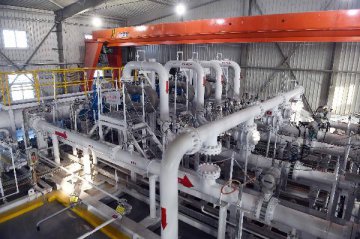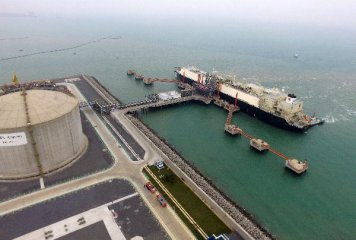Industry insiders said the gas shortage that hit China last winter is unlikely to reoccur this year, thanks to rising competition among domestic suppliers, a more open and liberalized domestic gas sector and more international supply agreements.
As a result of government efforts to increase liquefied natural gas imports and step up natural gas pipeline construction, the chances are low that the country will see a repeat of last winter's supply/demand imbalance despite growing demand for natural gas, said Li Li, research director at energy consulting company ICIS China.
"The government has taken on board lessons from last year, and is placing a higher focus on ensuring sufficient gas supply with better planning in advance to avoid shortages," Li said.
However, Li also warned that the government should further encourage construction of gas storage tanks and pipelines, as well as other LNG infrastructure facilities. This would prevent future gas shortages during cold snaps, considering the country's high dependence on oil and gas imports, she said.
Wang Lu, Asia-Pacific oil and gas analyst at Bloomberg Intelligence, said China's current storage capacity is experiencing bottlenecks. She said China should increase its underground gas storage to ease pressure during peak gas demand in winter.
Bloomberg Intelligence estimated that nationwide gas storage will rise to 4.1 percent of demand in 2020, compared with 2.8 percent in 2015.
Insufficient domestic production and limited pipeline imports are contributing to the continuous growth in LNG imports by sea, she said.
Wang estimated that China's LNG imports will see average annual growth of 17 percent from 2017 to 2020, accounting for 30 percent of the country's total gas consumption in the early 2020s.
In 2017, China's natural gas production and imports totaled 148 billion cubic meters and 94.6 billion cubic meters, respectively, up 8.2 percent and 26.9 percent on the previous year.
China is currently the world's third-largest gas consumer, after the United States and Russia, according to Wang.
"However, China's gas usage accounts for only about 6 percent of its energy mix, substantially lower than the 24 percent global average," she said.
China overtook South Korea as the world's second-largest LNG importer in 2017 with 38 million metric tons, 46 percent higher than a year ago.
The increase in natural gas demand aligns with China's ambition to encourage the use of gas for heating instead of burning coal, to combat air pollution.
China aims to increase the share of gas in its energy mix to 10 percent of the nation's primary energy demand by 2020, according to the National Development and Reform Commission, the nation's top economic regulator.
As a result of government efforts to increase liquefied natural gas imports and step up natural gas pipeline construction, the chances are low that the country will see a repeat of last winter's supply/demand imbalance despite growing demand for natural gas, said Li Li, research director at energy consulting company ICIS China.
"The government has taken on board lessons from last year, and is placing a higher focus on ensuring sufficient gas supply with better planning in advance to avoid shortages," Li said.
However, Li also warned that the government should further encourage construction of gas storage tanks and pipelines, as well as other LNG infrastructure facilities. This would prevent future gas shortages during cold snaps, considering the country's high dependence on oil and gas imports, she said.
Wang Lu, Asia-Pacific oil and gas analyst at Bloomberg Intelligence, said China's current storage capacity is experiencing bottlenecks. She said China should increase its underground gas storage to ease pressure during peak gas demand in winter.
Bloomberg Intelligence estimated that nationwide gas storage will rise to 4.1 percent of demand in 2020, compared with 2.8 percent in 2015.
Insufficient domestic production and limited pipeline imports are contributing to the continuous growth in LNG imports by sea, she said.
Wang estimated that China's LNG imports will see average annual growth of 17 percent from 2017 to 2020, accounting for 30 percent of the country's total gas consumption in the early 2020s.
In 2017, China's natural gas production and imports totaled 148 billion cubic meters and 94.6 billion cubic meters, respectively, up 8.2 percent and 26.9 percent on the previous year.
China is currently the world's third-largest gas consumer, after the United States and Russia, according to Wang.
"However, China's gas usage accounts for only about 6 percent of its energy mix, substantially lower than the 24 percent global average," she said.
China overtook South Korea as the world's second-largest LNG importer in 2017 with 38 million metric tons, 46 percent higher than a year ago.
The increase in natural gas demand aligns with China's ambition to encourage the use of gas for heating instead of burning coal, to combat air pollution.
China aims to increase the share of gas in its energy mix to 10 percent of the nation's primary energy demand by 2020, according to the National Development and Reform Commission, the nation's top economic regulator.





















Latest comments